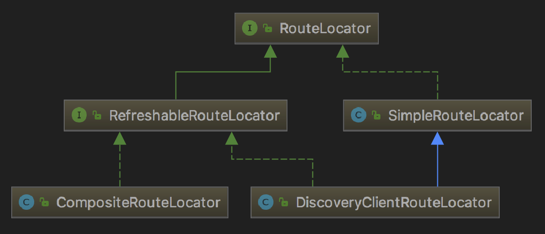路由
路由是网关的核心功能,既然在spring的框架下,那就要按Spring的规矩来。
路由规则类:org.springframework.cloud.netflix.zuul.filters.Route 维护这以下信息:
private String id;
private String fullPath;
private String path;
private String location;
private String prefix;
private Boolean retryable;
private Set<String> sensitiveHeaders = new LinkedHashSet<>();
private boolean customSensitiveHeaders;
private boolean prefixStripped = true;
路由规则维护:RouteLocator
public interface RouteLocator {
/**
* Ignored route paths (or patterns), if any.
*/
Collection<String> getIgnoredPaths();
/**
* A map of route path (pattern) to location (e.g. service id or URL).
*/
List<Route> getRoutes();
/**
* Maps a path to an actual route with full metadata.
*/
Route getMatchingRoute(String path);
}
类结构如下:

自动配置代码:
@Bean
@ConditionalOnMissingBean(DiscoveryClientRouteLocator.class)
public DiscoveryClientRouteLocator discoveryRouteLocator() {
return new DiscoveryClientRouteLocator(this.server.getServletPrefix(),
this.discovery, this.zuulProperties, this.serviceRouteMapper, this.registration);
}
@Bean
@Primary
public CompositeRouteLocator primaryRouteLocator(
Collection<RouteLocator> routeLocators) {
return new CompositeRouteLocator(routeLocators);
}
@Bean
@ConditionalOnMissingBean(SimpleRouteLocator.class)
public SimpleRouteLocator simpleRouteLocator() {
return new SimpleRouteLocator(this.server.getServletPrefix(),
this.zuulProperties);
}
这里会使用DiscoveryClientRouteLocator,它做了一个事就是利用DiscoveryClient把注册中心的信息捞过来直接做映射成为路由规则列表。具体代码写的也有差点意思的,比如下图:

首先有ZuulController和ZuulHandlerMapping,请求进来先在ZuulHandlerMapping里的列表上找有没有,如果有就把请求丢给ZuulController处理。所以里面一定维护这个一个<path,ZuulController>这么个map。这个匹配规则哪里来呢,一般我们认为是配置,但这里用了spring cloud,它加了注册的微服务动态加入匹配规则的逻辑,也就是下面的DiscoveryClientRouteLocator。
ZuulHandlerMapping的lookupHandler方法:
protected Object lookupHandler(String urlPath, HttpServletRequest request) throws Exception {
if (this.errorController != null && urlPath.equals(this.errorController.getErrorPath())) {
return null;
}
if (isIgnoredPath(urlPath, this.routeLocator.getIgnoredPaths())) return null;
RequestContext ctx = RequestContext.getCurrentContext();
if (ctx.containsKey("forward.to")) {
return null;
}
if (this.dirty) {
synchronized (this) {
if (this.dirty) {
registerHandlers();
this.dirty = false;
}
}
}
return super.lookupHandler(urlPath, request);
}
private void registerHandlers() {
Collection<Route> routes = this.routeLocator.getRoutes();
if (routes.isEmpty()) {
this.logger.warn("No routes found from RouteLocator");
}
else {
for (Route route : routes) {
registerHandler(route.getFullPath(), this.zuul);
}
}
}
这里看到this.dirty来控制是不是重新调用registerHandlers,看代码是执行一遍后,列表被存下来后面进来就用这个列表就行了。这里有一个点,就是每次心跳事件,就是应用和注册中心保持的心跳的时候会把这个重新改成true,从而再执行到locateRoutes方法,就可以重新在内存里拿注册中心可能同步过来的新的信息。
注意ZuulProxyAutoConfiguration中ZuulDiscoveryRefreshListener的onApplicationEvent方法:
public void onApplicationEvent(ApplicationEvent event) {
if (event instanceof InstanceRegisteredEvent) {
reset();
}
else if (event instanceof ParentHeartbeatEvent) {
ParentHeartbeatEvent e = (ParentHeartbeatEvent) event;
resetIfNeeded(e.getValue());
}
else if (event instanceof HeartbeatEvent) {
HeartbeatEvent e = (HeartbeatEvent) event;
resetIfNeeded(e.getValue());
}
}
private void resetIfNeeded(Object value) {
if (this.monitor.update(value)) {
reset();
}
}
private void reset() {
this.zuulHandlerMapping.setDirty(true);
}
locateRoutes方法就是从注册中心同步过来的所有注册的应用,转成一个个路由规则,如果自己在配置上配置了的路由规则,则按配置的来,没配置的就补上。这里注意了,也就是说不管你配置没配置,只要注册上来的,这个网关的路由规则上就有!问题是,很多微服务提供的接口并不想给网关用,甚至从分层的角度上来说某些应用属于基础服务应用,只想给上层的业务应用调用,并不想直接由网关暴露出去。那么是不是有问题呢,这个也不算是问题,人家提供的框架本来就是要你在这个基础上改造的。这个后续再讲。
locateRoutes方法:
protected LinkedHashMap<String, ZuulRoute> locateRoutes() {
LinkedHashMap<String, ZuulRoute> routesMap = new LinkedHashMap<String, ZuulRoute>();
routesMap.putAll(super.locateRoutes());
if (this.discovery != null) {
Map<String, ZuulRoute> staticServices = new LinkedHashMap<String, ZuulRoute>();
for (ZuulRoute route : routesMap.values()) {
String serviceId = route.getServiceId();
if (serviceId == null) {
serviceId = route.getId();
}
if (serviceId != null) {
staticServices.put(serviceId, route);
}
}
// Add routes for discovery services by default
List<String> services = this.discovery.getServices();
String[] ignored = this.properties.getIgnoredServices()
.toArray(new String[0]);
for (String serviceId : services) {
// Ignore specifically ignored services and those that were manually
// configured
String key = "/" + mapRouteToService(serviceId) + "/**";
if (staticServices.containsKey(serviceId)
&& staticServices.get(serviceId).getUrl() == null) {
// Explicitly configured with no URL, cannot be ignored
// all static routes are already in routesMap
// Update location using serviceId if location is null
ZuulRoute staticRoute = staticServices.get(serviceId);
if (!StringUtils.hasText(staticRoute.getLocation())) {
staticRoute.setLocation(serviceId);
}
}
if (!PatternMatchUtils.simpleMatch(ignored, serviceId)
&& !routesMap.containsKey(key)) {
// Not ignored
routesMap.put(key, new ZuulRoute(key, serviceId));
}
}
}
if (routesMap.get(DEFAULT_ROUTE) != null) {
ZuulRoute defaultRoute = routesMap.get(DEFAULT_ROUTE);
// Move the defaultServiceId to the end
routesMap.remove(DEFAULT_ROUTE);
routesMap.put(DEFAULT_ROUTE, defaultRoute);
}
LinkedHashMap<String, ZuulRoute> values = new LinkedHashMap<>();
for (Entry<String, ZuulRoute> entry : routesMap.entrySet()) {
String path = entry.getKey();
// Prepend with slash if not already present.
if (!path.startsWith("/")) {
path = "/" + path;
}
if (StringUtils.hasText(this.properties.getPrefix())) {
path = this.properties.getPrefix() + path;
if (!path.startsWith("/")) {
path = "/" + path;
}
}
values.put(path, entry.getValue());
}
return values;
}